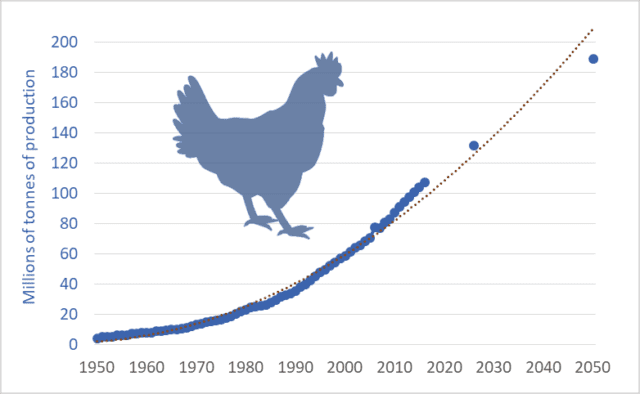There are approximately 23 billion chickens on the planet right now. But because the life of a meat chicken is short—less than 50 days—annual production far exceeds the number of chickens alive at any one time. In 2016, worldwide, chicken production topped 66 billion birds. Humans are slaughtering, processing, and consuming about 2,100 chickens per second.
We’re producing a lot of chicken meat: about 110 million tonnes per year. And we’re producing more and more. In 1966, global production was 10 million tonnes. In just twelve years, by 1978, we’d managed to double production. Fourteen years after that, 1992, we managed to double it again, to 40 million tonnes. We doubled it again to 80 million tonnes by 2008. And we’re on track for another doubling—a projected 160 million tonnes per year before 2040. By mid-century, production should exceed 200 million tonnes—20 times the levels in the mid-’60s. This week’s graph shows the steady increase in production. Data sources are listed below.
The capacity of our petro-industrial civilization to double and redouble output is astonishing. And there appears to be no acknowledged limit. Most would predict that as population and income levels rise in the second half of the century—as another one or two billion people join the “global middle class”—that consumption of chicken and other meats will double again between 2050 and 2100. Before this century ends, consumption of meat (chicken, pork, beef, lamb, farmed fish, and other meats) may approach a trillion kilograms per year.
Currently in Canada the average chicken farm produces about 325,000 birds annually. Because these are averages, we can assume that the output of the largest operations is several times this figure. In the US, chicken production is dominated by contracting. Large transnationals such as Tyson Foods contract with individual growers to feed birds. It is not unusual for a contract grower to have 6 to 12 barns on his or her farm and raise more than a million broiler chickens per year.
We’re probably making too many McNuggets. We’re probably catching too many fish. We’re probably feeding too many pigs. And it is probably not a good idea to double the number of domesticated livestock on the planet—double it to 60 billion animals. It’s probably time to rethink our food system.
Graph sources:
FAOSTAT database
OECD-FAO, Agricultural Outlook 2017-2026
Brian Revell: One Man’s Meat … 2050?
Lester Brown: Full Planet, Empty Plates
FAO: World Agriculture Towards 2030/2050, the 2012 revision


A sobering reminder of our consumption. The book “Sapiens” by Harari stated that a best estimate of domestic animal mass worldwide is about 700 million tonnes, humans 300 million tonnes, and wildlife 100 million tonnes….and diminishing.
Great point, Steven. I plan to do a blog post on that soon. The fact that we have triggered the fastest extinction event in 65 million years is connected to the fact that humans and our domesticates outnumber/outweigh wild animals 8 or 10 to 1.